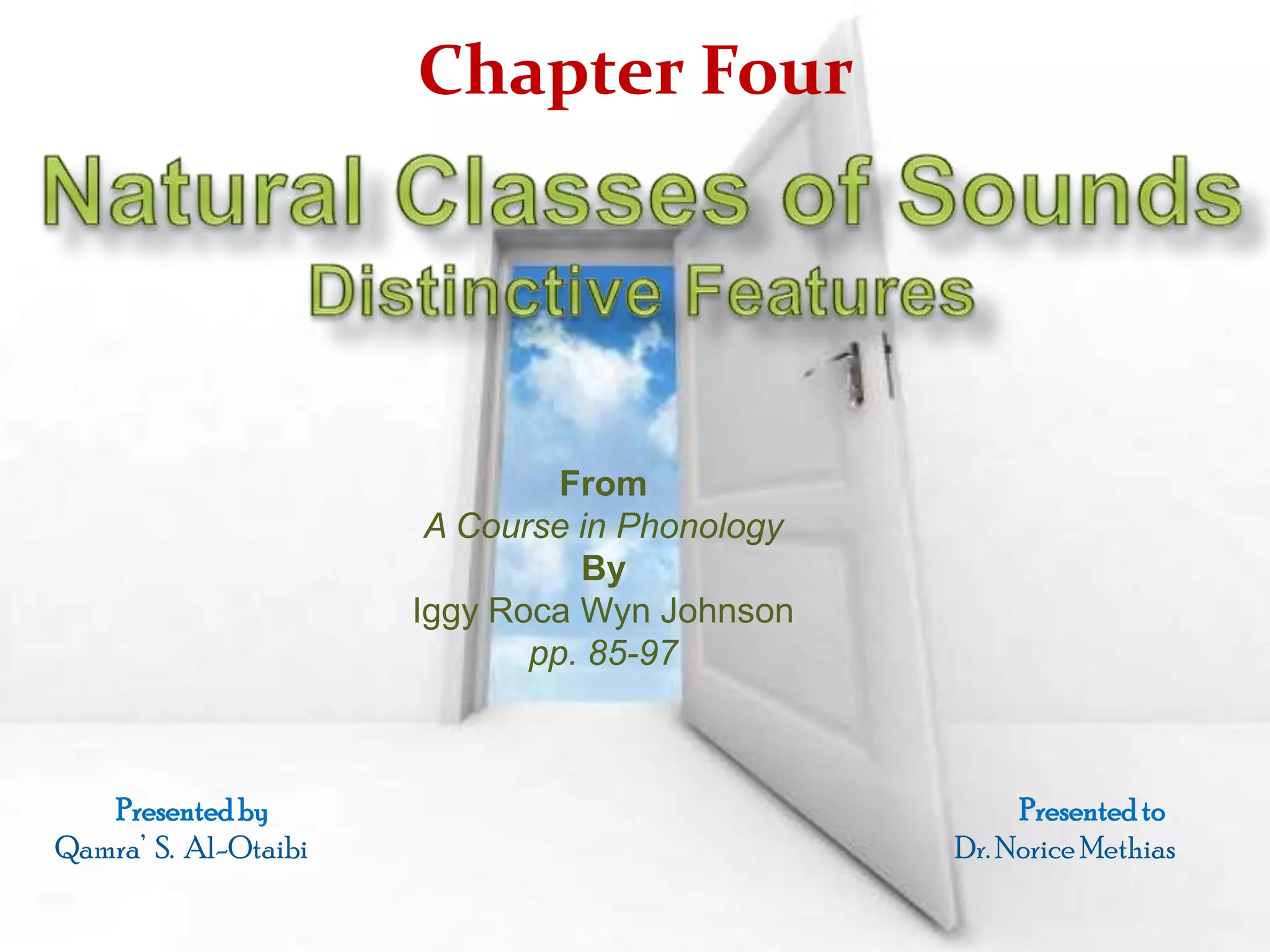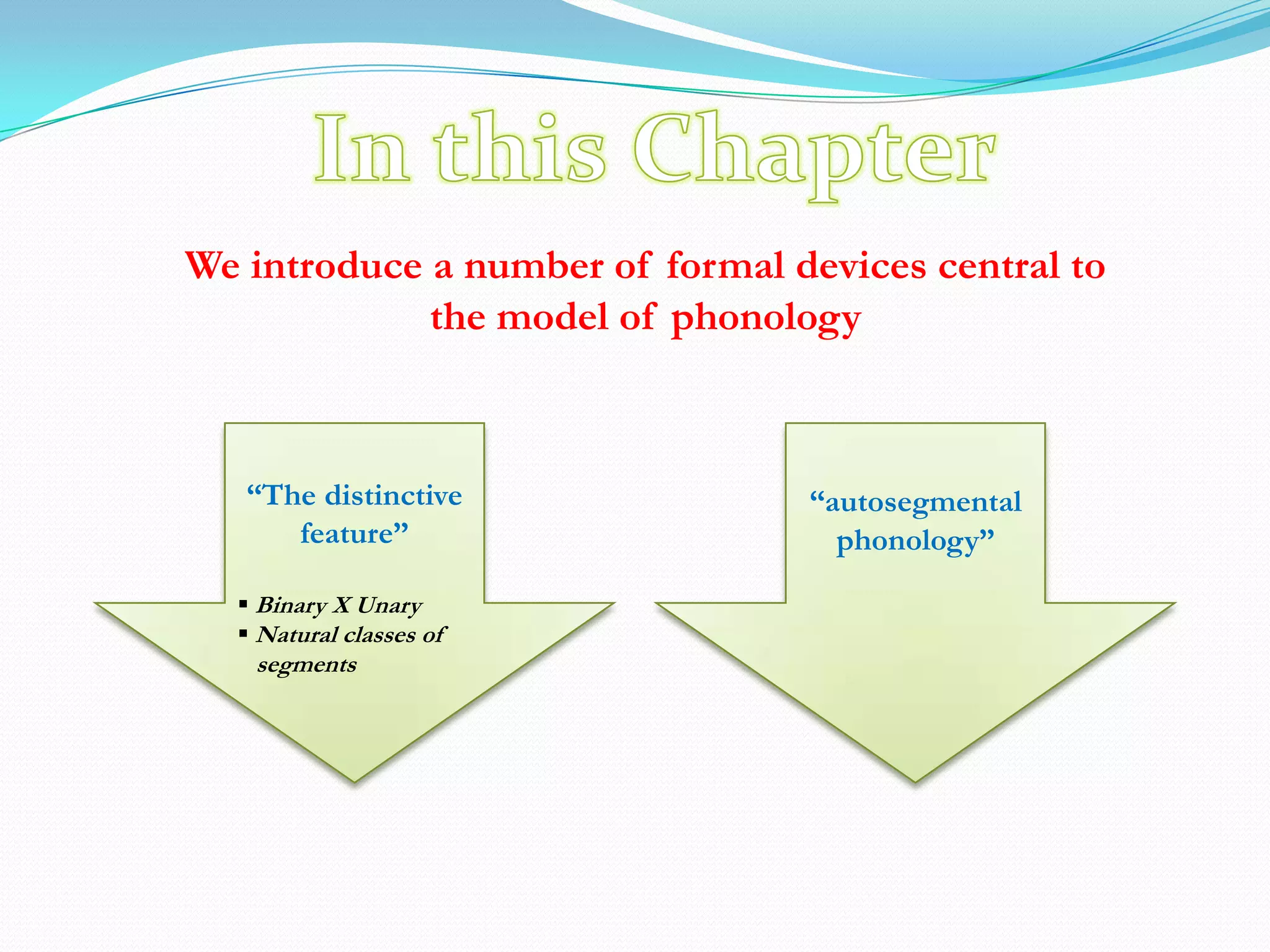1. The document summarizes key concepts from Chapter 4 of the textbook "A Course in Phonology". It introduces formal devices used in phonology models like distinctive features and autosegmental phonology.
2. Distinctive features are binary features that describe sounds and allow them to be classified into natural classes based on shared phonetic properties. This provides an efficient way to write phonological rules by replacing phonetic symbols.
3. The chapter discusses examples of assimilation rules and how distinctive features allow the rules to be written more concisely and capture generalizations compared to using phonetic symbols alone.






![an important step in the process:
The negation “non-” will be expressed by the negative algebraic symbol “-”, so
that, for instance, we will write “non-sonorant” as “-sonorant”. We will write
“sonorant” with the opposite algebraic symbol, “+”: [+ sonorant]
The kernel of the process:
A restricted set of “DISTINCTIVE FEATURES”
Why distinctive?
The keep sound distinct
Why features?
They express properties of the sounds:
Endowed with an alternative binary value:
Positive value if the property named by the label is present in the sound being
defined, and negative if it is not.
The relationship between the phonetic parameters and the distinctive
features?
The distinctive features simply translate the phonetic parameters in a self-
explanatory manner.
Exercise, page 89](https://image.slidesharecdn.com/chapter4naturalclassesofsoundsdistinctivefeatures-130105070835-phpapp01/75/Chapter4-natural-classes-of-sounds-distinctive-features-7-2048.jpg)
![• Distinctive feature labels
Distinctive feature labels are always enclosed in square brackets. Such labels are
preceded by the operations + or – expressing the precise value of the feature:
[ sonorant] stands for either [+sonorant] or [-sonorant], and so on.
What is the relationship between the list of distinctive features and
UNIVERSAL GRAMMAR?
The list of distinctive features is provided once and for all for all languages: it
is assumed to be part of UNIVERSAL GRAMMAR, the set of principles for
language all humans are endowed with innately. The
Is the list of distinctive features universal?
list of distinctive features is assumed to be universal
by pretty well all phonologists, its actual contents
vary slightly from proposal to proposal : you must not
lose sight of the fact that, like any other aspect of
phonology, this list is hypothetical, given the
conjectural, rather than mechanistic, nature of the
enterprise.](https://image.slidesharecdn.com/chapter4naturalclassesofsoundsdistinctivefeatures-130105070835-phpapp01/75/Chapter4-natural-classes-of-sounds-distinctive-features-8-2048.jpg)
![The advantages of the system proposed by the
author
(the distinctive features)
1. Ideal to implement classification of the
sounds of speech, set of consonants, to be
more precise. It immediately brings out
both the criteria for classification and the Ideal to
exact position of any given element in the implement
system. classification
unambiguous
2. Maximally simple (it should only contain of the sounds
of speech
features necessary to implement
classification).
3. Clear (each value is immediately clear
transparent), e.g. [-sonorant] refers to non-
sonorants, that is, obstruent.
4. Unambiguous: there is no chance of
missing the complementarity between simple
[+sonorant] and [-sonorant], as there would
be if we used the labels “sonorant” and
“obstruent”.](https://image.slidesharecdn.com/chapter4naturalclassesofsoundsdistinctivefeatures-130105070835-phpapp01/75/Chapter4-natural-classes-of-sounds-distinctive-features-9-2048.jpg)
![Phonetic symbols are very useful when we want a written record of language sounds.
However, they are not at all helpful when we want to find or explain sound patterns.
Example:
• The assimilation of /p/ to [P] , /p/ changes to [P]
1. Rule1: (1) P P / — f
• The assimilation of /b/ to [B] , /b/ changes to [B]
Rule2: b B / — f
•The assimilation of /m/ to [ɱ], /m/ changes to [ɱ]
Rule3: m ɱ / — f
Since the assimilation process also occur in front of /v/, we double the set of the three
rules:
• The assimilation of /p/ to [P] , /p/ changes to [P]
Rule4: (1) P P / — v
•The assimilation of /b/ to [B] , /b/ changes to [B]
Rule5: b B / — v
•The assimilation of /m/ to [ɱ], /m/ changes to [ɱ]
Rule6: m ɱ / — v](https://image.slidesharecdn.com/chapter4naturalclassesofsoundsdistinctivefeatures-130105070835-phpapp01/75/Chapter4-natural-classes-of-sounds-distinctive-features-10-2048.jpg)

![Examples
(2) intolerant
(3) impossible
/m/ and /n/ in the negative prefixes in- and –im.
They are both [+sonorant], [-continuant], [+voice], [+nasal]
/m/ Labial, /n/ alveolar
Question
What is the lexical consonant of /m/ and /n/ in the negative prefixes in- and –
im?
Hypothesis
/in/ is the lexical form of the negative prefix in- (-im and –in are one and the
same prefix).
Test
The general ides is that the sound that has the wider distribution is lexical,
whereas the sound or sounds with a more limited distribution is or created by
contextually restricted rule(s). To test this hypothesis, there are two strategies](https://image.slidesharecdn.com/chapter4naturalclassesofsoundsdistinctivefeatures-130105070835-phpapp01/75/Chapter4-natural-classes-of-sounds-distinctive-features-12-2048.jpg)
![ looking for the next best environment in the same set of forms.
Extending the data set in other directions.
looking for the next best environment in the same set of forms
Initial-vowel base environment
(4) Inability
There is little reason to believe that the prefix-final nasal will assimilate to a following
vowel. The nasal in the prefix turns up as [n] in ALL CASES
Extending the data set in other directions
(5) Ten pens (te[m] pens), ten doors (te[n] doors).
(6) Some pens, some doors.
Conclusion
Rule of labial assimilation for nasals
(7) [coronal] [labial] / [ ______] [labial]
+nasal
• we are now replacing phonetic symbols with distinctive features.
•Rule (7) states that a coronal nasal immediately preceding a labial itself becomes labial.
The distinctive features are superior over the phonetic symbols in the formulation of
rules
Rules should be formulated in as economical a manner as possible.](https://image.slidesharecdn.com/chapter4naturalclassesofsoundsdistinctivefeatures-130105070835-phpapp01/75/Chapter4-natural-classes-of-sounds-distinctive-features-13-2048.jpg)
![• What is the definition of the feature[coronal] ?
[coronal encodes alveolar place of articulation. It refers to a movement of the
blade of the tongue.
• what is the definition of “coronal” concerning the terminology?
The expression “coronal” is defined as ‘pertaining’ to the blade of the tongue.
• What do we mean by “Natural Classes”?
The assumption behind the distinctive feature model is that similarity of behaviour
follows directly from membership of a common class: each feature defines a class.
For example, the feature relevant in the present case is “coronal”. The sounds [t],
[d], [s], [z], [θ], [ð], [ʃ], [ʒ], [tʃ], and [dʒ], among others, are defined as [coronal],
since they all involve a gesture of the tongue blade.](https://image.slidesharecdn.com/chapter4naturalclassesofsoundsdistinctivefeatures-130105070835-phpapp01/75/Chapter4-natural-classes-of-sounds-distinctive-features-14-2048.jpg)
![Active and Passive articulators
A more substantial point in connection with the feature
[coronal] concerns the reference it makes to the active,
rather than the passive, articulator: notice that there are
no features [alveolar], [dental], etc.](https://image.slidesharecdn.com/chapter4naturalclassesofsoundsdistinctivefeatures-130105070835-phpapp01/75/Chapter4-natural-classes-of-sounds-distinctive-features-15-2048.jpg)
